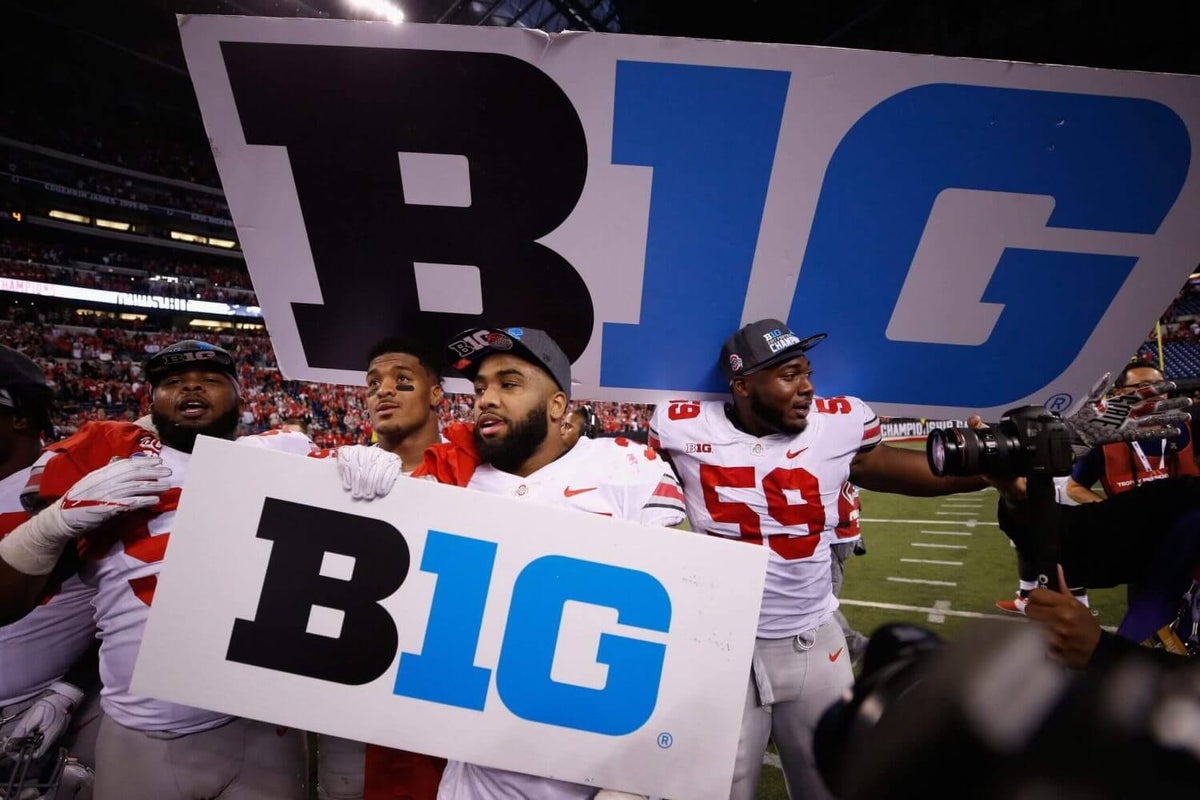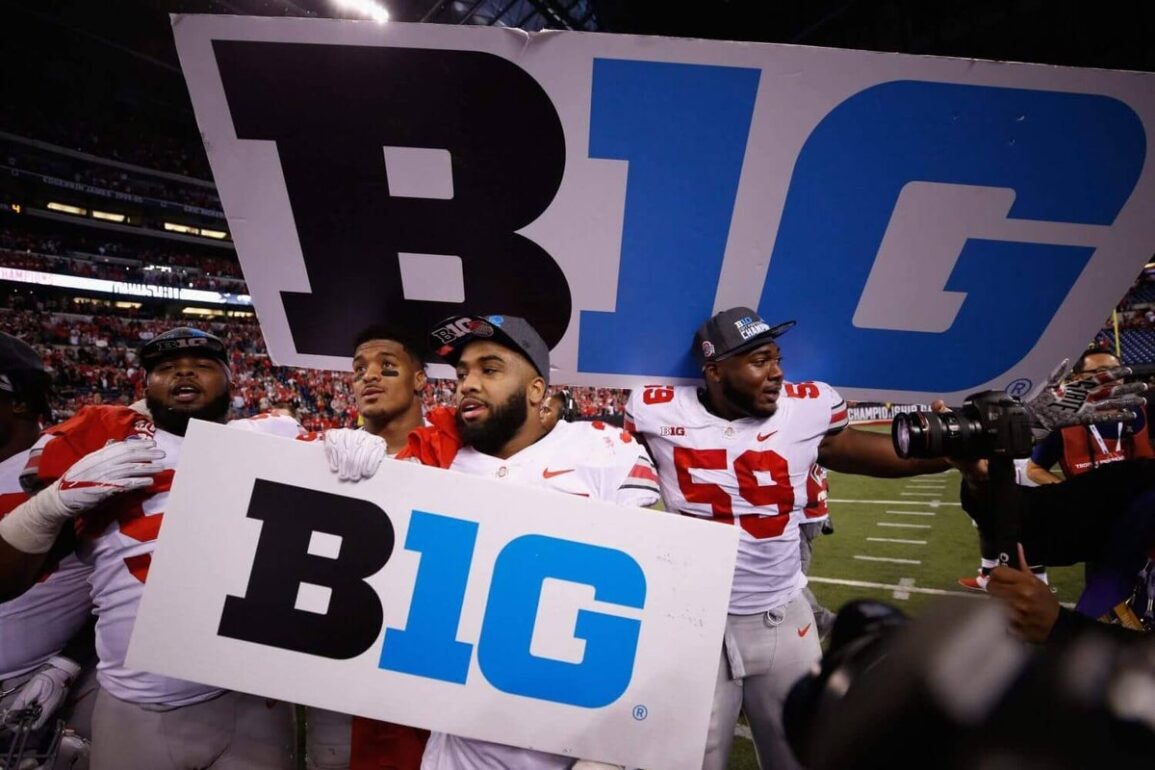
Five months after winning its second consecutive College Football Playoff national championship, the Big Ten has emerged bruised and battered from the process of proposing automatic qualifiers for an expanded CFP beginning with the 2026 season.
The Big Ten has for months recommended a CFP plan that would give four automatic bids to itself and the SEC, two each to the ACC and Big 12 and one for the top conference champion from the other six leagues (4+4+2+2+1). If the size of the postseason expands from 12 to 16, as almost all stakeholders expect, the format allows for three at-large selections to make the field.
Advertisement
Other conferences have come out against it, strongly so in some cases. The ACC and Big 12 are in lockstep with a “5+11” plan, which would give the five highest-ranked conference champions and 11 highest-ranked at-large teams entry into the Playoff. The SEC appears to be trending in that direction, too, after commissioner Greg Sankey supplied media with a multi-page breakdown of his league’s strength-of-schedule prowess last week.
No longer wounded by their 1-5 record against the Big Ten during the 2024-25 postseason, Sankey and SEC officials have successfully flipped the narrative. The Big Ten now looks like the arrogant bad actor hell-bent on enriching itself at the expense of its competition and the sport. Despite the Big Ten’s prolonged silence on this topic and others, people in and around the league have expressed that’s not the case.
The Big Ten is willing to budge on guaranteed CFP qualifiers, but the uneven number of conference games among the power leagues gives the Big Ten pause on allowing a selection committee to wield the power of placing 11 at-large teams in the CFP field. The Big Ten and Big 12 play nine league games; the SEC and ACC play eight. Thirteen of the Big Ten’s 18 teams compete against at least 10 power-conference opponents in 2025; 13 of the SEC’s 16 teams face only nine power-conference teams. Unless the SEC moves to nine league games, don’t expect the Big Ten to move on wanting guaranteed CFP slots. There’s too much scheduling variance.
The Big Ten has historical grounds to distrust a system that was supposed to reward strength of schedule and other concrete metrics and instead leaned into subjectivity to make prior selections. In July 2015, former Big Ten commissioner Jim Delany brought out slides and unveiled his “1910” scheduling plan, designed to make his conference champion competitive for the four-team CFP. The numbers represented one title game, nine league games, one intersectional power-conference opponent and no contests against Football Championship Subdivision competition. Delany believed his strategy would position the Big Ten well for its best team to earn a CFP spot and for non-champions to make New Year’s Six bowl games.
Advertisement
“I think that’s responsive to what the College Football Playoff committee is looking for,” Delany said at the time. “We think it’s what our fans want. We think it’s what our players want. And we think it’s what the College Football Playoff committee wants.”
Delany found out he was wrong, and he was furious. In 2017 and 2018, Big Ten champion Ohio State missed the CFP. It played nonconference games against Oklahoma in ’17 and TCU in ’18. The 2017 Buckeyes beat No. 6 Wisconsin, No. 9 Penn State and No. 16 Michigan State, but they finished fifth, behind Alabama, which beat only two teams that made the final rankings (No. 17 LSU, No. 23 Mississippi State) and didn’t win its division.
Considering Alabama won the national title that year, that was more of a disappointment than a snub to Delany. But in 2018, the committee disregarded the strategy with stakes one rung below the Playoff. In the final CFP rankings, Florida came in at No. 10 with LSU at No. 11 and Penn State at No. 12. All three teams were 9-3, but the SEC teams moved up to New Year’s Six bowls.
Again, the strength of schedule disparity chapped Delany most. Florida played four nonconference games: two FCS opponents, Colorado State (3-9) and Florida State (5-7). The Gators’ three losses came by an average of 17 points. Penn State played three nonconference games, including one against ACC Coastal Division champion Pittsburgh and 11-2 Appalachian State. Penn State’s losses came to 13-1 Ohio State, 10-3 Michigan and 7-6 Michigan State. Yet Delany felt the committee ignored nonconference scheduling when stacking those teams.
“The actual language in the founding document says, ‘When comparing teams with similar records and similar resumes, should look at strength of schedule as well as winning conference championships,’” Delany said in 2019. “I’m not sure that the strength of schedule or the conference championship has been adequately rewarded, in my personal view.”
Advertisement
The recent disagreements over selection criteria for the 12-team CFP date to what transpired in 2017 and 2018. Last year, Indiana finished 11-1 in the regular season, but a trio of 9-3 SEC teams barked about scheduling when the Hoosiers earned a CFP spot over them. Indiana’s overall strength of schedule metrics were weak, but by the end of the postseason, it was the only team in the nation to play both the 2023 (Michigan, Washington) and 2024 CFP finalists (Ohio State, Notre Dame). The Hoosiers were one of just two Big Ten squads to face only nine power-conference opponents last year, but the trio of SEC teams had also played just nine power-conference teams.
The nine-game schedule matters to the Big Ten because of the risks involved — it creates one extra loss for half the league compared to the SEC. Ohio State’s lone conference losses in each of the 2017 and 2018 seasons came at West Division schools. Had the Big Ten played only eight league contests those years, Ohio State might not have traveled to those venues.
Although the push for four guaranteed slots appears self-serving, out of the Power 4 leagues, only the Big Ten would have seen its number of CFP participants drop in the last four years with that plan compared to the 5+11 model, based on each power conference’s current composition.
With the 5+11 plan, the Big Ten would have qualified 20 teams, one more than the SEC (19), while the Big 12 and ACC would have 10 and nine, respectively. In a 4-4-2-2-1 model, the SEC and ACC numbers would stay the same, while the Big Ten’s would drop by two and the Big 12’s would rise by two. In a 5+11 plan, the SEC would have had three qualifiers in 2021 and ’22 but seven in ’23 and six in ’24.
Without uniform scheduling, Big Ten officials are concerned that an open 5+11 plan would cause more schools to ease up on their nonconference slates rather than play other power-conference schools; one recently called it a “race to the bottom.” With guaranteed spots, nonconference games would have little impact on CFP qualification. Without guaranteed spots, teams may protect their records and not risk playing high-level nonconference games.
Lastly, without divisional play in a larger conference, Big Ten officials believe guaranteed slots provide more teams with a major goal, especially if the Big Ten (and possibly the SEC) added two play-in games to decide some of its spots in a 16-team CFP. Had that format taken place last year, Indiana would have played Iowa and Illinois would have played Ohio State in December with CFP berths at stake.
“I love that,” Illinois coach Bret Bielema told The Athletic this spring. “It makes all the games meaningful.”
Advertisement
The Big Ten and SEC have control over the next CFP era, so it’s up to them, with consultation from other conferences, to find the best path forward. But until the Big Ten’s scheduling concerns are met, don’t expect it to fold anytime soon on its desire for guaranteed CFP bids.
(Photo of Ohio State’s 2017 Big Ten title game win: Joe Robbins / Getty Images)
This post was originally published on this site be sure to check out more of their content.






